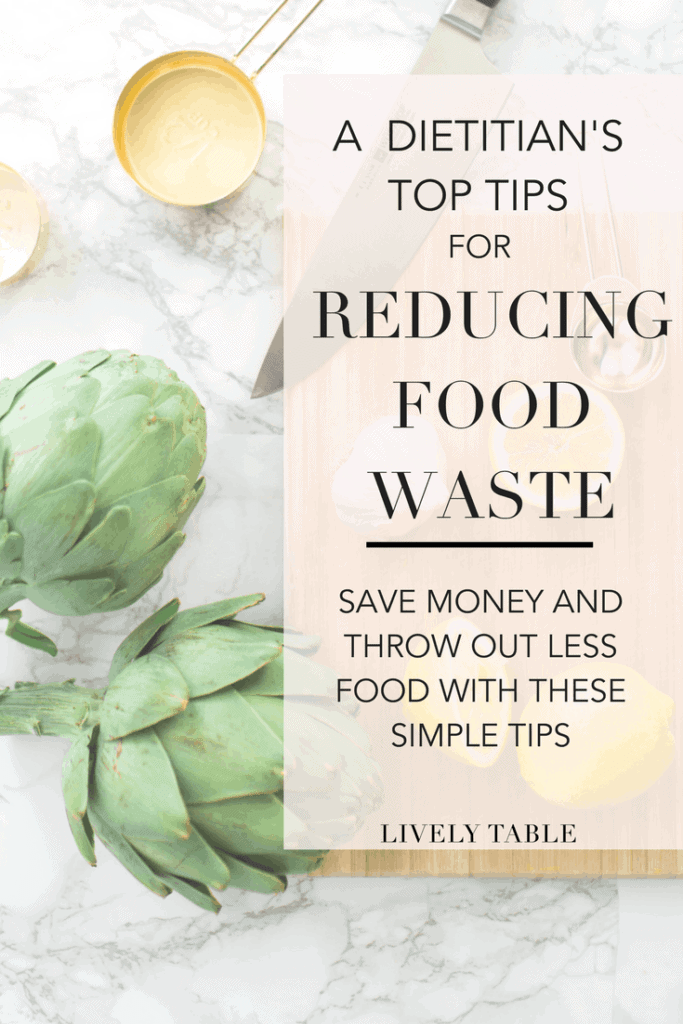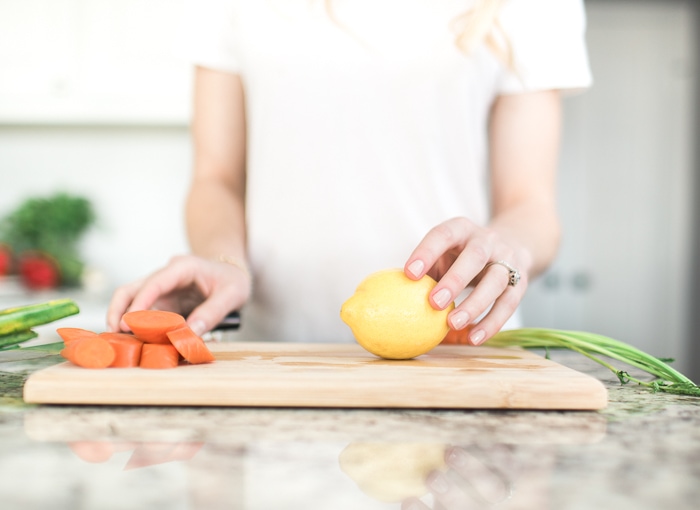Sadly, so much food goes to waste, and a lot of it is on our own homes. Use these tips to help you minimize food waste in your own kitchen for a healthier planet (and a healthier bank account)!

Americans throw out $218 billion of food annually. That's more than enough food to feed the 42 million Americans who are food insecure each year. That food waste goes straight to landfills, producing harmful greenhouse gasses, impacting the environment both directly and indirectly as all the resources, like water, labor, and energy used to grow, produce, and transport that food also ends up wasted. On a personal level, food waste just breaks my heart. I feel guilty throwing out food because not only am I throwing away money, but I'm also throwing out what could have gone to nourish somebody else, perhaps somebody less fortunate than me. So I try to make every effort to keep the food waste in my house to a minimum, something I think we can all look at in our own homes and try to be mindful of as we go about our weeks.
I encourage you to take a look at your own family's habits and evaluate where you improve when it comes to throwing out food. Then incorporate some of these tips for reducing food waste into your everyday routine. Not only will you reduce the impact of food waste on the planet, but you'll also save some money along the way.

My Top Tips for Reducing Food Waste in Your Home
Make a Plan
Reducing food waste starts before you go to the grocery store. Take a look in your refrigerator before you go shopping to evaluate what perishables you have that need to be used. Plan your meals and snacks for the week around what you already have and what will be going bad soon. Then make a list and stick to it. Buy only what you need until your next shopping trip to avoid buying too much food that might not get eaten before it spoils.
Freeze It
Speaking of food spoiling, pay attention to what is about to go bad that you aren't going to get to. Freeze what you can to avoid throwing out fruit, vegetables, yogurt, milk, meat, fish, and prepared dishes like soups. Freeze milk and yogurt in ice cube trays and freeze fruit, like berries or sliced bananas, and leafy greens for smoothies. Place poultry and meat or fish in the freezer (we love our vacuum sealer for this) for later meals. You can also freeze soups and stews, cooked grains, and other prepared dishes to eat later when you don't have time to meal prep. Vegetables like green beans, broccoli and asparagus can be blanched before freezing for a side dish that cooks quickly when you need it. You can also freeze small amounts of vegetables like peppers, mushrooms and onions to be used in omelets, casseroles, and soup as they build up. Finally, make pesto out of fresh herbs and freeze it in ice cube trays to quickly add flavor to weeknight meals.
Only Buy What You Know You Will Eat
Shopping in bulk can be a great way to save money, but it's not a good deal if you end up throwing it away. Make sure your family will eat what you buy before it goes bad. We like to vacuum seal meat, poultry, and fish and freeze it if there is a good deal on bigger packages. The same goes for fresh fruit and vegetables. Even if they are on special, resist the urge to buy too much that could end up spoiling.
Shop More Frequently
Instead of making one big grocery trip, make a couple of smaller ones throughout the week. Despite our best intentions, plans can change and you may end up eating out or eating leftovers one night instead of cooking. If you only shop for the next few days at once, you are more likely to buy only what you need, knowing you're coming back to the store in a few days.
Eat Your Leftovers
Leftovers don't do any good sitting in your fridge if you don't eat them. We usually put our leftovers into individual portions for lunches. If you aren't a big fan of reheated leftovers, try to repurpose your leftover food into new meals. Roasted vegetables can always be turned into a delicious grain bowl or breakfast scramble, while leftover chicken can be turned into anything from chicken salad to enchiladas. Get creative!
Store Your Food Strategically
Try to place things that spoil more quickly where you can see them so you don’t forget they are there. Try placing fruit or cut-up vegetables in see-through containers at eye level. Also, make sure you keep your refrigerator clean and uncluttered so that food doesn't get pushed to the back to spoil. Over-stuffed fridges and freezers run less efficiently, costing you money and circulating cool air poorly.
Embrace the Ugly
Sadly, produce that doesn't look pristine often doesn't get sold from grocery store shelves despite being perfectly edible. Make an effort to buy the awkward shaped fruits and veggies so that they don't get tossed out. And don't ignore the less than perfect produce in your fridge. A small bruise can easily be cut away so that you can enjoy the rest.
Use The Scraps
Have you ever thought about why you cut out the kale stalks or peel your carrots? You really don't have to. I usually don't. Even if you do cut away things like broccoli stalks, you can use them, along with things like beet or radish greens, in salads, soups or stir-fries. Greens like carrot tops can also be used in pesto. Finally, plenty of other scraps, like onion, carrot, and celery ends, herb stalks, parmesan rinds, and chicken carcasses can be used to make homemade broth.
Compost (Or Get a Pet!)
I realize composting is not practical for everyone, but if you can, throw any food scraps you have in a compost pile. If you live in a small space, this FoodCycler from Vitamix is amazing, especially if you have a garden! I have been using it for a few weeks now and love it for turning food scraps into compost quickly (and without the smell!). Dogs and chickens are also great recyclers. Our dogs love zucchini ends, salmon skin, and carrots for treats on top of their dog food. Chickens can also eat almost any non-meat table scraps.
A Note on Food Safety
While you don't want to throw out food that is still good to eat, don't risk it when it comes to food safety for you and your family. If something smells funky or has mold or slime growing on it, toss it. Prepared dishes, proteins and dairy foods that have been left out for more than 2-4 hours should not be eaten, especially in hot weather. Also, don't use cans that are rusted or dented, as they may be contaminated.
Top Tools For Reducing Food Waste
- FoodSaver Vacuum Sealer
- Pyrex Glass Storage Containers
- Souper Cubes Trays for freezing liquids, sauces, and herbs
- Vitamix FoodCycler for small space composting
Stats taken from this report by the NRDC.


Chelsea's Healthy Kitchen says
I'm a big advocate for reducing food waste/waste in general as well. Love all your practical tips in this post! I'm actually teaching a meal planning class tomorrow (I work as a grocery store dietitian) and cover a lot of these same points. I'm definitely going to add your point about storing food that goes bad quickly at the front of the fridge to my lesson plan - such a good point! 🙂
Kaleigh says
Thanks Chelsea! So great that you're teaching a class on reducing waste!
Emily @ Zen & Spice says
Hehe our dog loves scraps too! He loves carrot peels and iceberg lettuce the most. We also meal plan and I grocery shop once a week. I only cook dinner about 2-3 times a week and my husband and I eat the same dinner two or three nights in a row and it works for us!
Kaleigh says
Sounds like some great strategies, and less work for you! 🙂